Ahoj čtenáři a čtenářky!
Jistě jste si všimli, že pravidlové okénko bylo v poslední době poněkud “zavřené”. Abych situaci do budoucna napravil, oslovil jsem kolegy rozhodčí, zda by přiložili ruku k dílu. Za dnešní článek tedy můžete zejména poděkovat Karlovi Jílkovi, DCI rozhodčímu z Prahy.
Vydání edice Eldritch Moon je za dveřmi, a tak se pojďme společně podívat, jaké pravidlové novinky na nás v této sadě čekají.
Pokud jste tak nějak “zaspali dobu”, doporučuji si nejdříve přečíst novinky z minulé edice. Potom to bude snad dávat trochu větší smysl.
Karty se schopností Meld
Wizardi nám během více než dvacetileté historie Magicu nabídli spoustu zajímavých mutací jednotlivých karet. Setkali jsme se s kartou, na které byly vytištěny dvě kartičky. Měli jsme k dispozici karty, na kterých byla další karta natištěna vzhůru nohama. Později se objevily ještě kousky, které měly něco natištěno z druhé strany a podle určitých událostí se otáčely. No a s novou sadou přichází něco na způsob Big Furry Monster, kterou si budeme moci legálně zahrát na turnajích a ne jen v Un- sadě. Podívejme se, jak to funguje.
 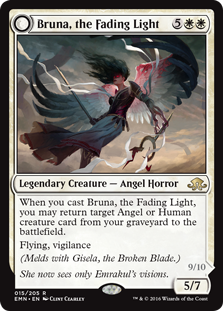
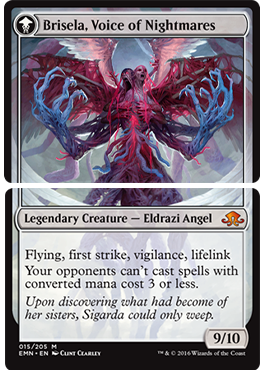
Jedná se vždy o dvě karty, které za určitých okolností, na nich napsaných, můžeme otočit a složit z nich jednu velkou bytost. “Velkou” nejen svým vlivem na situaci ve hře, ale také tím, že je natištěna na dvou kartách, stejně jako dříve zmíněná Big Furry Monster. Navzdory své velikosti je to však potvora jako každá jiná, a tudíž se k ní všelijaká zabíjecí kouzla, enchantmenty atd. chovají úplně normálně. Každá dvojice karet se schopností Meld má nějakou jinou podmínku, například Hanweir Battlements má aktivační abilitu.
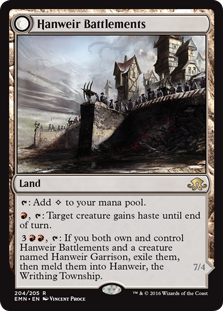
“Výroba” meldované bytosti se provede přes exil, a tudíž se z původních potvor ztratí všechny countery, aury atd.
Vypadá to jednoduše, ne? Tak se podívejme do temných koutů pravidel, jak to bude fungovat v praxi.

Řekněme, že soupeř má výše zmíněnou dvojici andělů, je konec jeho kola a těší se, že nás již brzy obrovským andělem přejede. My máme na ruce Lightning Bolt. Zvládneme se tomu ubránit? Ano, stačí v reakci na Giselinu schopnost zastřelit jednoho ze dvou andělů a soupeř má po srandě (celý trigger se odstraní ze stacku a neudělá nic).
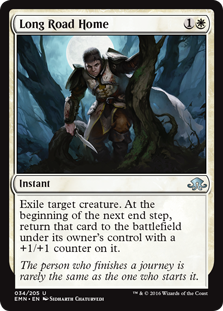
Tohle už je trochu složitější. Na stole je nějaká krásná velká meldovaná bytost a zahraju na ni Long Road Home. Řekli jsme si, že kouzla na tyto potvory fungují úplně normálně, takže dvě karty tvořící velkého anděla vezmeme, otočíme zpátky na menší anděly a dáme je do exilu. Co se ale stane, když potom exilnutou potvoru vracíme do hry s +1/+1 counterem?
Na bojiště bystosti chodí ve své původní podobě, tudíž se naše kreatura vrátí v podobě dvou menších andělů a každý z nich na sobě bude mít +1/+1 counter, který získal od Long Road Home. Dodejme ještě, že v tom samém end stepu se ve velkého anděla nepromění (začátek end stepu už propásli).
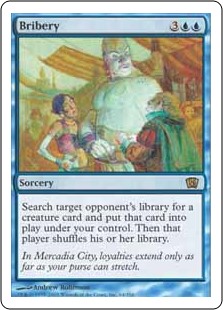
Zde se zaměříme na klauzuli “both own and control”. “Own” znamená “mít kartu na začátku hry v balíčku” a “control” znamená “mít kartu na své straně bojiště”. Tedy pokud soupeři jednoho anděla seberu například pomocí Bribery a druhého vyložím ze své ruky, tak se žádného Meldu nedočkám, protože sice kontroluji oba anděly, ale jeden z nich “není můj”.
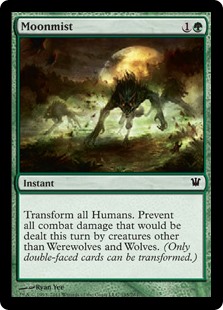
Dále je dobré zmínit, že Meld karty nejsou z pohledu pravidel “double-faced” karty. A tedy nejdou transformovat. Platí pro ně ale analogické pravidlo jako pro ty oboustranné: converted mana cost “druhé strany” (tj. velké Brisely) se určí z ceny lícové strany. Takže CMC Brisely je součtem cen Bruny a Gisely (tj.11).
Co o Meld říkají pravidla:
701.34. Meld
701.34a Meld is a keyword action that appears in an ability on one card in a meld pair. (See rule 712, “Meld Cards.”) To meld the two cards in a meld pair, put them onto the battlefield with their back faces up and combined. The resulting permanent is a single object represented by two cards.
701.34b Only two cards belonging to the same meld pair can be melded. Tokens, cards that aren’t meld cards, or meld cards that don’t form a meld pair can’t be melded.
701.34c If an effect instructs a player to meld cards that can’t be melded, they stay in their current zone.
Example: A player owns and controls Midnight Scavengers and a token that’s a copy of Graf Rats. At the beginning of combat, both are exiled but can’t be melded. Midnight Scavengers remains exiled.
712. Meld Cards
712.1. A meld card has a Magic card face on one side and half of an oversized Magic card face on the other. It doesn’t have a Magic card back.
712.1a There are three specific meld pairs. Each meld pair consists of two specific cards whose back faces combine to form one oversized Magic card face: Midnight Scavengers and Graf Rats meld to form Chittering Host; Hanweir Garrison and Hanweir Battlements meld to form Hanweir, the Writhing Township; and Bruna, the Fading Light and Gisela, the Broken Blade meld to form Brisela, Voice of Nightmares.
712.1b A meld card isn’t a double-faced card. It can’t transform or enter the battlefield transformed. (See rule 711, “Double-Faced Cards.”)
712.2. One card in each meld pair has an ability that exiles both that object and its counterpart and melds them. To meld the two cards in a meld pair, put them onto the battlefield with their back faces up and combined (see rule 701.34, “Meld”). The resulting permanent is a single object represented by two cards.
712.3. The front face of each meld card and the combined face formed by a meld pair each has its own set of characteristics.
712.3a While a meld card is outside the game, in a zone other than the battlefield, or on the battlefield with its front face up, it has only the characteristics of its front face.
712.3b While the two cards of a meld pair are on the battlefield as a melded permanent, the object rep-resented by those cards has only the characteristics of the combined back face, except that its converted mana cost is the sum of the converted mana costs of its front faces. If a permanent is copying a melded permanent, the converted mana cost of the copy is 0. See rule 202.3c.
712.3c Anything that needs information about a meld card sees only the information given by the face that is currently up.
Example: A Clone enters the battlefield as a copy of Chittering Host (the combined back face of a meld pair). It will have the characteristics of Chittering Host, even though the object it becomes is represented by only a single card.
712.4. If a melded permanent leaves the battlefield, one permanent leaves the battlefield and two cards are put into the appropriate zone.
Example: Chittering Host, a melded permanent, dies. An ability that triggers “whenever a creature dies” triggers once. An ability that triggers “whenever a card is put into a graveyard from anywhere” triggers twice.
712.4a If a melded permanent is put into its owner’s graveyard or library, that player may arrange the two cards that represented it in any order. If it’s put into its owner’s library, that player doesn’t reveal the order.
712.4b If a player exiles a melded permanent, that player determines the relative timestamp order of the two cards at that time. This is an exception to the procedure described in rule 613.6j.
Example: Duplicant is a card with the abilities “When Duplicant enters the battlefield, you may exile target nontoken creature” and “As long as a card exiled with Duplicant is a creature card, Duplicant has the power, toughness, and creature types of the last creature card exiled with Duplicant. It’s still a Shapeshifter.” As Duplicant’s first ability exiles Chittering Host, a melded permanent, Duplicant’s controller chooses whether the last creature card exiled is Midnight Scavengers or Graf Rats.
712.4c If an effect can find the new object that a melded permanent becomes as it leaves the battlefield, it finds both cards. (See rule 400.7.) If that effect causes actions to be taken upon those cards, those actions are taken upon each of them.
Example: False Demise is an Aura with the ability “When enchanted creature dies, return that card to the battlefield under your control.” A Chittering Host enchanted by False Demise dies. The triggered ability returns both Midnight Scavengers and Graf Rats to the battlefield.
Example: Otherworldly Journey is an instant that reads “Exile target creature. At the beginning of the next end step, return that card to the battlefield under its owner’s control with a +1/+1 counter on it.” A player casts Otherworldly Journey targeting Chittering Host, a melded permanent. Chittering Host is exiled. At the beginning of the next end step, Midnight Scavengers and Graf Rats are both returned to the battlefield, each with a +1/+1 counter on it.
712.4d If a melded permanent moves to another zone, both cards move to that zone. If multiple re-placement effects could be applied to the zone change, applying one to one of the two cards affects both cards. If the melded permanent is a commander, it may be exempt from this rule; see rule 903.9a.
Example: Leyline of the Void is an enchantment that reads, in part, “If a card would be put into an op-ponent’s graveyard from anywhere, exile it instead.” Wheel of Sun and Moon is an Aura with enchant player and the ability “If a card would be put into enchanted player’s graveyard from anywhere, instead that card is revealed and put on the bottom of its owner’s library.” If the controller of Chittering Host is affected by both cards’ effects, that player chooses one effect to apply to the event and Midnight Scavengers and Graf Rats are both moved to the appropriate zone.
712.5. Players who are allowed to look at a meld card may look at its half of the combined back face. Players may access Oracle text for the other member of the meld pair and the combined face at any time (see rule 108.1).
712.6. Meld cards in a player’s deck may be represented by checklist cards. See rule 713, “Checklist Cards.”
712.8. If a meld card is cast as a spell, it’s put on the stack with its front face up. See rule 601, “Casting Spells.”
712.9. A meld card enters the battlefield with its front face up unless it’s being melded with its coun-terpart.
712.10. If an effect allows a player to cast a meld card as a face-down spell, or if a meld card enters the battlefield face down, it will have the characteristics given to it by the rule or effect that caused it to be face down. That card remains hidden, using either a face-down checklist card or opaque sleeves. See rule 707, “Face-Down Spells and Permanents.”
712.11. Meld cards on the battlefield and melded permanents can’t be turned face down. If a spell or ability tries to turn such a permanent face down, nothing happens.
712.12. If an effect instructs a player to name a card, the player may name the front face of a meld card or the combined back face of a meld pair.
Schopnost Emerge
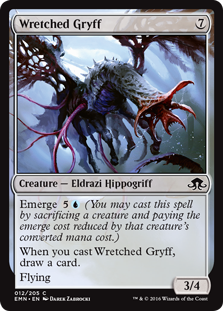
Po poměrně komplikovaném Meldu tu máme něco trochu jednoduššího. Emerge vlastně nedělá nic víc, než je na Gryffovi napsáno. Buď jej můžu zahrát normálně za 7 man, nebo obětovat jednu potvoru (řekněme třeba Dawn Gryff) a vyčarovat jej za 5 man a jednu modrou, přičemž z těch pěti man dostaneme ještě za obětovaného Dawn Gryffa slevu o další tři, takže konečná sesílací cena budou dvě bezbarvé many a jedna modrá. To na 3/4 létající bytost není vůbec špatné, ne?
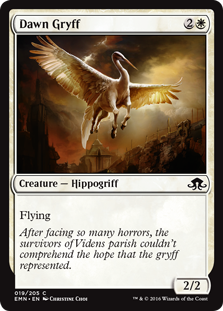
Doplňme ještě, že obětování dražší potvory než za 5 man nám v případě Wretched Gryffa nijak nepomůže, vždy bude stát alespoň jednu modrou.
Seslání bytosti přes Emerge je čarování jako každé jiné, a tudíž nám soupeř může Gryffa normálně zrušit (např. Cancel). Nelze ale reagovat na volbu obětování bytosti. Jakmile máme prioritu, ohlásíme seslání Gryffa přes Emerge, obětujeme bytost a doplatíme zbytek. Gryff jde na stack teprve dávno poté, co je obětovaná bytost ve hřbitově, může někdo další hrát.
Co o Emerge říkají pravidla:
702.118. Emerge
702.118a Emerge represents two static abilities that function while the spell with emerge is on the stack. “Emerge [cost]” means “You may cast this spell by paying [cost] and sacrificing a creature rather than paying its mana cost” and “If you chose to pay this spell’s emerge cost, its total cost is reduced by an amount of generic mana equal to the sacrificed creature’s converted mana cost.” Paying a card’s emerge cost follows the rules for paying alternative costs in rules 601.2b and 601.2f–h.
702.118b You choose which creature to sacrifice as you choose to pay a spell’s emerge cost (see rule 601.2b), and you sacrifice that creature as you pay the total cost (see rule 601.2h).
Escalate
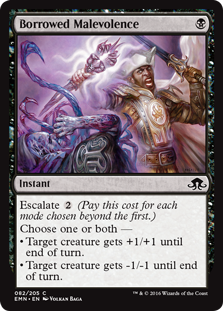
Opět schopnost, které zvládneme lehce porozumět. Mějme Borrowed Malevolenci. Můžeme ji seslat za jednu černou manu a vybrat si, jestli nějakou bytost posílíme nebo naopak oslabíme. A nebo můžeme seslat za dvě many a jednu černou, vybrat si dvě bytosti a udělat obojí. Kdybychom měli na výběr ještě něco třetího, můžeme připlatit další dvě many a opět si vybrat jeden, dva nebo dokonce všechny tři módy. Jistě chápete, jak to funguje.
Každý mód lze vybrat jen jednou. Musím tak učinit už při sesílání, tedy ještě předtím, než soupeř dostane možnost reagovat a volbu nelze později měnit, a to včetně případných cílů.
Pokud dám kartě s Escalate ještě Flashback (například Snapcaster Mage) nebo dostanu povolení ji zahrát zadarmo či se mi podaří ji jakýmkoli jiným “podvodem” seslat (Isochron Scepter), tak mám v základu pouze jeden výběr a za každý další si musím připlatit Escalate, úplně stejně, jako když kartu hraju z ruky.
 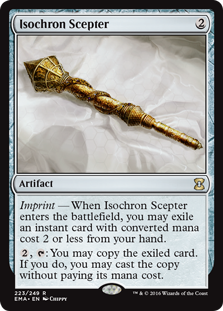
Co o Escalate říkají pravidla:
702.119. Escalate
702.119a Escalate is a static ability of modal spells (see rule 700.2) that functions while the spell with escalate is on the stack. “Escalate [cost]” means “For each mode you choose for this spell beyond the first, you pay an additional [cost].” Using the escalate ability follows the rules for choosing modes and paying additional costs in rules 601.2b and 601.2f–h.
702.119b If more than one mode is chosen, follow the text of each of the chosen modes in the order written on the card as the spell resolves.
Další schopnosti
V Eldritch Moonu se kromě velkých potvor dočkáme i klasických transformovacích karet, které známe už z Innistradu. Některé z nich mají místo měsíce na druhé straně symbol, že se připojily k potomstvu Emrakula. Toho se nijak nelekejte, na hru to nemá žádný vliv.
Dále vyjdou karty se schopností Madness, jejíž kořeny sahají někam do Time Spiralu, která nám umožňuje zahrát kartu v momentě, kdy ji zahazujeme z ruky. Z minulé sady přetrvá schopnost Delirium, dávající nějaký bonus v případě, že máme čtyři nebo více různých karetních typů v hrobě.
Doufáme, že se vám nová sada zatím líbí alespoň tak, jako nám. Přejeme všem hodně zábavy při jejím hraní. V případě, že se vám podaří vymyslet nějaký pravidlový špek, zeptejte se buď zde v komentářích nebo v pravidlové skupině na Facebooku, kde vám určitě někdo z rozhodčích poradí.
Tak hodně štěstí na prerelease a zase někdy při pravidlovém okénku naviděnou!
Karel Jílek a Milan “Flamberg” Majerčík
http://magic.wizards.com/en/articles/archive/feature/eldritch-moon-release-notes-2016-07-08
http://blogs.magicjudges.org/rules/cr/
|
|
|